Author: Matt Del Fiacco
The use of simple sugar to make beer stretches far back in the history of brewing, with Belgian brewers known for using a decent portion to assist in making their relatively high alcohol styles deliciously dry. Indeed, the primary sugar produced from malt during the mashing process, maltose, is quite fermentable, though not nearly as much as widely available simple sugars, namely dextrose and sucrose.
It’s not uncommon for brewers to view dextrose and sucrose as interchangeable, despite the fact the former comes from corn while the latter comes from either sugar cane or beets. This assumption makes some sense considering both sugars are 100% fermentable, though dextrose does contribute slightly fewer points per gallon (ppg)– 42 ppg compared to sucrose’s 46 ppg. However, there are some who avoid using sucrose due to concerns i can result in a cider-like off-flavor in their beer, a claim that is often repeated on homebrew forums and at club meetings.
I use simple sugar in a few styles such as Double IPA and Belgian Golden Strong Ale where my goal is to amp up the ABV without producing a chewy body, and my sugar of choice has always been dextrose. Surprised by the results of another recent xBmt on simple sugar, I couldn’t help but wonder what impact the type of sugar used in brewing might have and figured I’d check it out for myself!
| PURPOSE |
To evaluate the differences between beers made with either dextrose (corn sugar) or sucrose (table sugar).
| METHODS |
Wanting to stick with a simple grist to emphasize any differences, I went with a Belgian Golden Strong Ale for this xBmt, a style known for being made with a decent portion of simple sugar.
Radar Phone
Recipe Details
| Batch Size | Boil Time | IBU | SRM | Est. OG | Est. FG | ABV |
|---|---|---|---|---|---|---|
| 5 gal | 90 min | 30.4 IBUs | 2.6 SRM | 1.080 | 1.007 | 9.8 % |
| Actuals | 1.08 | 1.007 | 9.8 % | |||
Fermentables
| Name | Amount | % |
|---|---|---|
| Pilsner (2 Row) UK | 11.5 lbs | 82.88 |
| Corn Sugar (Dextrose) / Table Sugar (Sucrose) | 2.375 lbs | 17.12 |
Hops
| Name | Amount | Time | Use | Form | Alpha % |
|---|---|---|---|---|---|
| Magnum | 18 g | 60 min | Boil | Pellet | 12 |
| Czech Saaz | 30 g | 15 min | Boil | Pellet | 3.5 |
Yeast
| Name | Lab | Attenuation | Temperature |
|---|---|---|---|
| Gnome (B45) | Imperial Yeast | 74% | 65°F - 75°F |
Notes
| Water Profile: Ca 54 | Mg 11 | Na 25 | SO4 81 | Cl 65 |
Download
| Download this recipe's BeerXML file |
I started my brew day by collecting two identical volumes of RO water and adjusting them to the same profile before turning on the elements to heat them up.
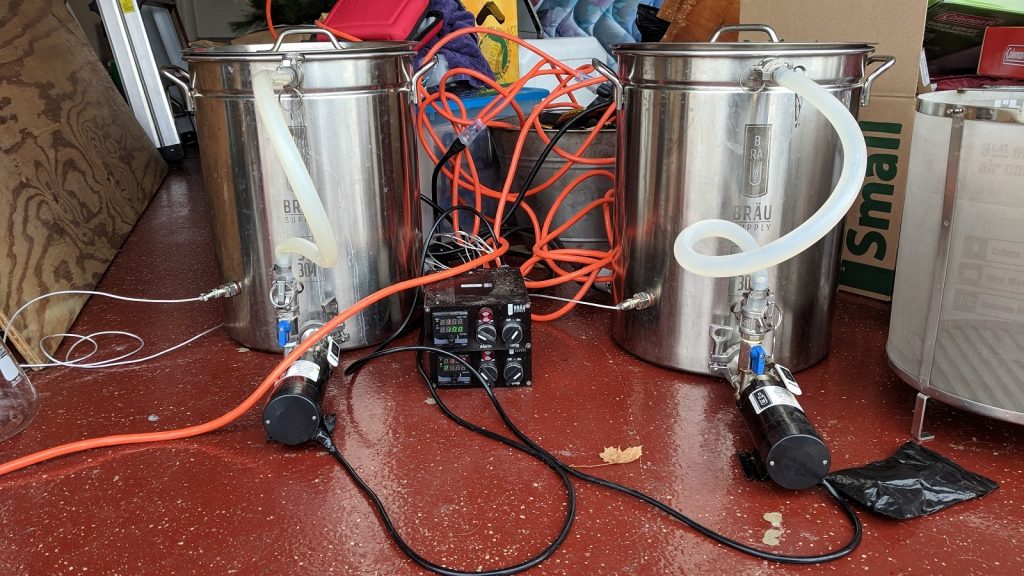
While the water was warming up, I weighed out and milled the grains for each batch.
With the water properly heated, I mashed in and checked to make sure each batch hit the same target mash temperature.
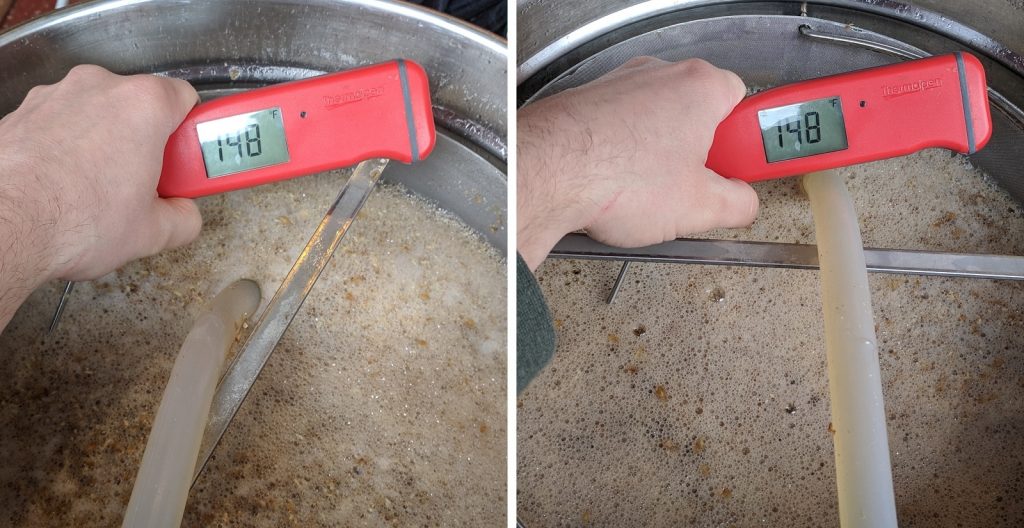
While the mashes were resting, I measured out the kettle hops for each batch.
Once each 60 minute mash was complete, I removed the grains then began heating the wort. At this point, I weighed out identical amounts of dextrose and sucrose, one for each batch.
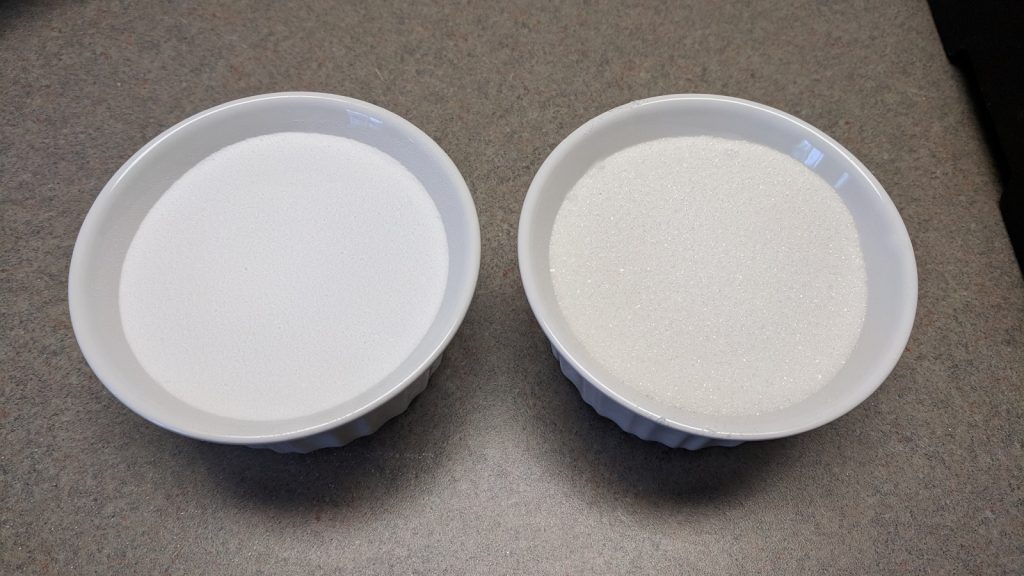
The worts were boiled for 60 minutes with the sugars being added at the 30 minute mark.
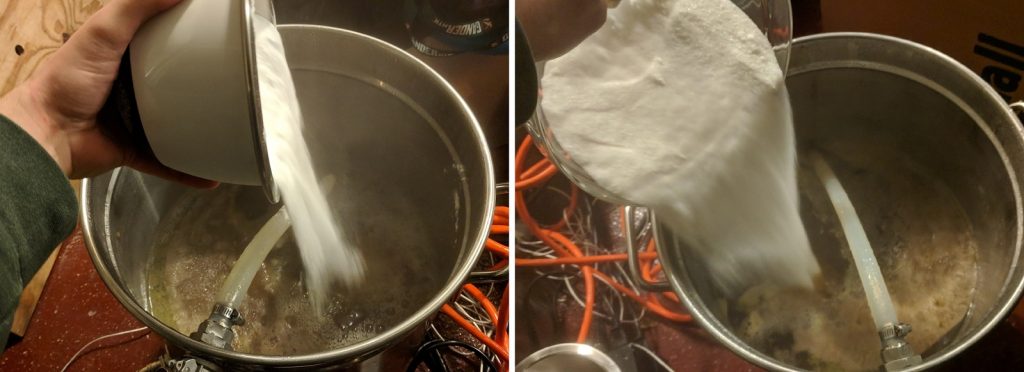
At the completion of each boil, the wort was quickly chilled with my CFC and run directly into sanitized fermentation kegs.
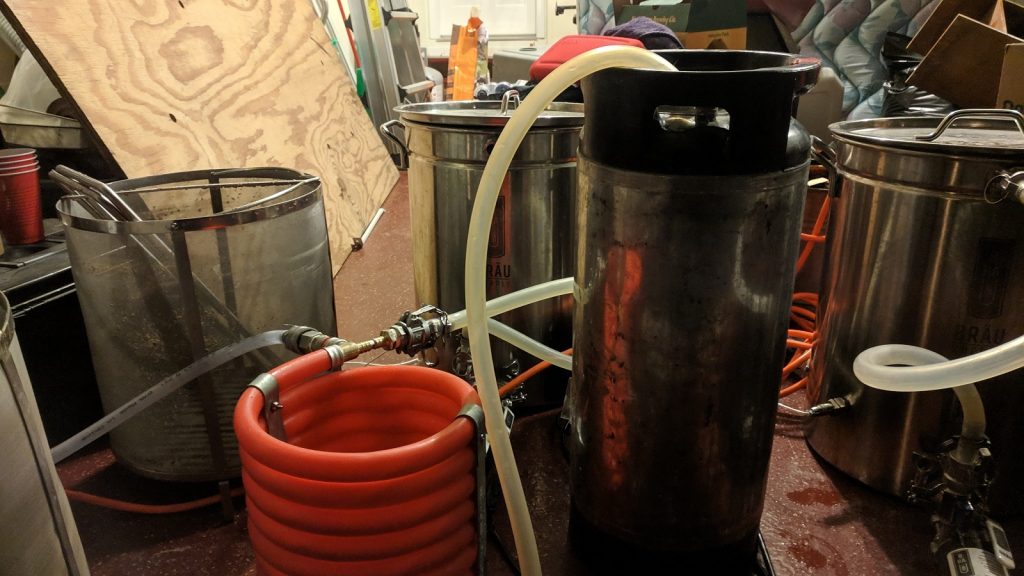
Using extra wort from each batch, I made vitality starters with Imperial Yeast B45 Gnome.
Hydrometer measurements revealed a very slight difference between the worts, confirming claims that sucrose contributes more gravity points per gallon.
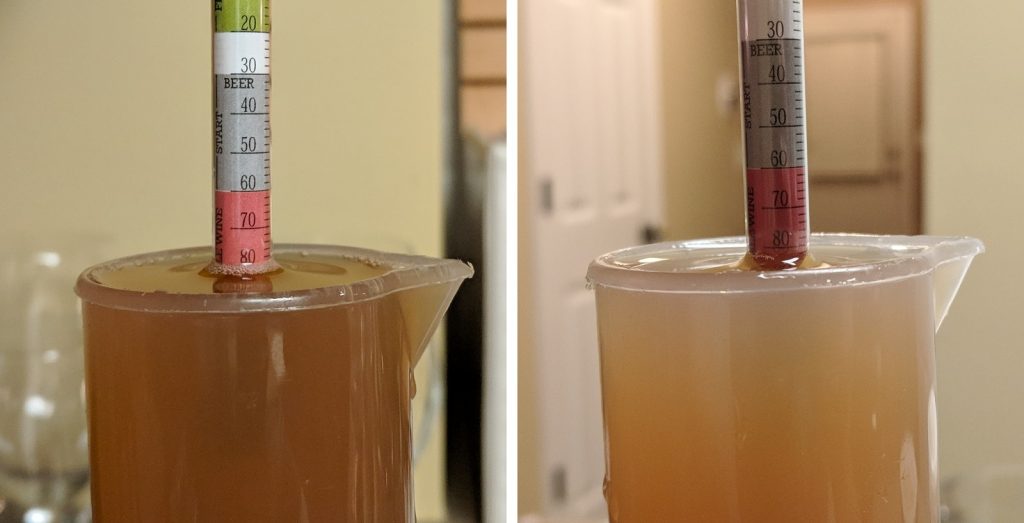
The filled fermentation kegs were placed in a chamber controlled to my desired fermentation temperature of 64°F/18°C and left for a couple hours before the yeast was pitched.
Both beers were actively fermenting just hours later. After 4 days, I began ramping the temperature in the chamber to 80°F/27°C over the course of 5 days, at which point I let them finish up for another week. Hydrometer measurements at this time showed similar attenuation between the beers.
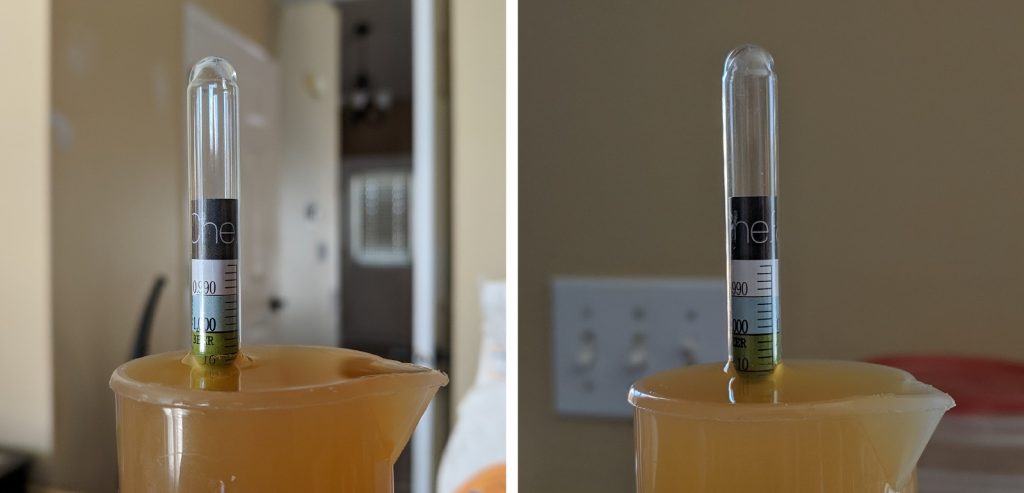
I pressure transferred the beers to sanitized and CO2 flushed serving kegs, which were placed on gas in my cool keezer. After a period of burst carbonation and a week of conditioning, the beers were ready for participants!
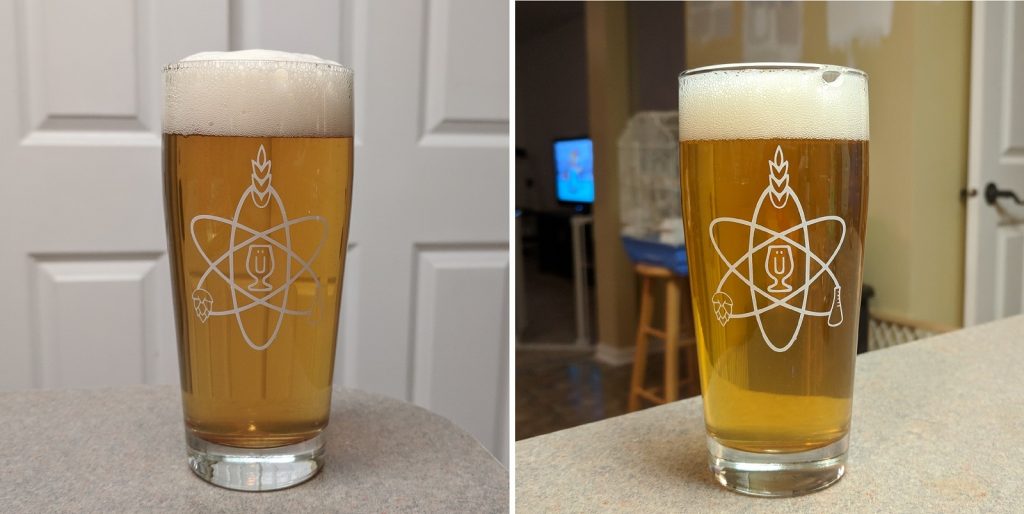
| RESULTS |
Special thanks to both P.A.L.E. Homebrew Club and Club Wort for allowing me access to members for data collection! A total of 30 people of varying levels of experience participated in this xBmt. Each participant was served 1 sample of the beer made with dextrose and 2 samples of the beer made with sucrose in different colored opaque cups then asked to identify the unique sample. While 15 tasters (p<0.05) would have had to identify the unique sample in order to reach statistical significance, 18 (p=0.002) made the accurate selection, indicating participants in this xBmt could reliably distinguish a Belgian Golden Strong Ale made with corn sugar from one made with table sugar.
The 18 participants who made the accurate selection on the triangle test were instructed to complete a brief preference survey comparing only the beers that were different. A total of 8 tasters reported preferring the dextrose beer and 10 liked the sucrose beer more.
My Impressions: I had an easy time telling these beers apart, accurately identifying the odd-beer-out in 5 out of 6 semi-blind triangle tests. I perceived the beer made with sucrose to have an almost harsh character to it with what seemed to be a somewhat sweeter aroma and flavor, characteristics that were absent in the dextrose version. While I enjoyed both beers, my preference was for the beer made with dextrose.
| DISCUSSION |
With both dextrose and sucrose being white, powdery, and perceptibly sweet, it makes sense people would think they’d have a similar flavor impact when used in the relatively small portions called for in some beer recipes. Then again, they do come from different sources, so claims that each imparts a unique characteristic are also completely understandable, and the fact tasters in this xBmt were able to reliably distinguish beers made with either dextrose or sucrose supports this notion.
Without getting too chemistry heavy, there are some interesting differences between dextrose and sucrose, namely that the former is made of just a single sugar molecule while the latter consists of both a glucose and fructose molecule. Perhaps the additional molecule of fructose, a sugar found in fruit, is what’s responsible for the cider-like flavors some claim to perceive when brewing with sucrose, and possibly the subtle harshness I detected in the batch I made with table sugar.
Dextrose has tended to be my go-to when using sugar in beer, but I never really harbored strong feelings either way and admittedly didn’t expect this xBmt to return significant results. Because I was able to consistently tell the beers apart and preferred the one made with dextrose, I’ll stick with what I’ve been doing, though I’d certainly have no issues substituting sucrose in a pinch.
If you have any thoughts about this xBmt, please do not hesitate to share in the comments section below!
Support Brülosophy In Style!
All designs are available in various colors and sizes on Amazon!
Follow Brülosophy on:
FACEBOOK | TWITTER | INSTAGRAM
If you enjoy this stuff and feel compelled to support Brulosophy.com, please check out the Support page for details on how you can very easily do so. Thanks!

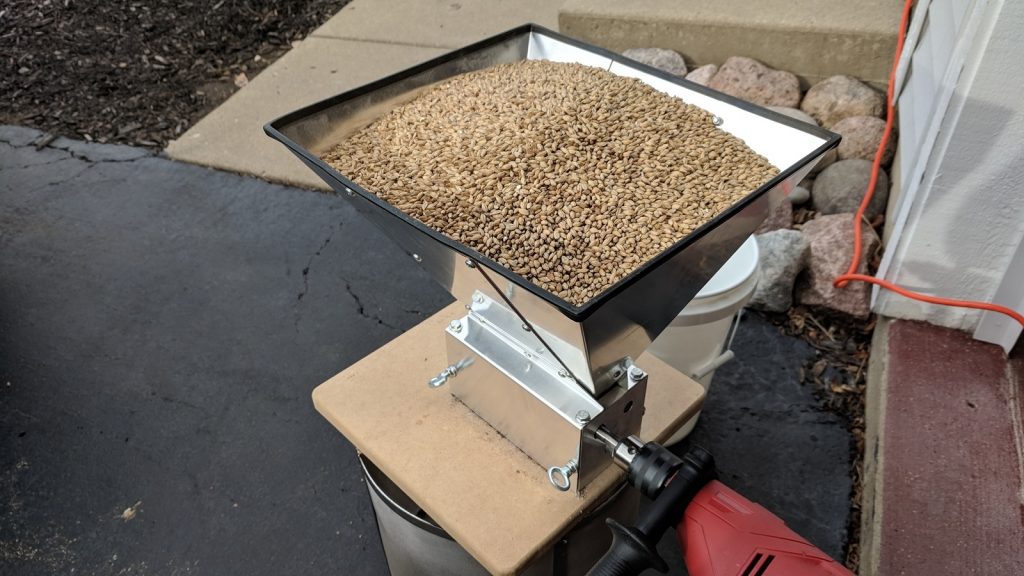
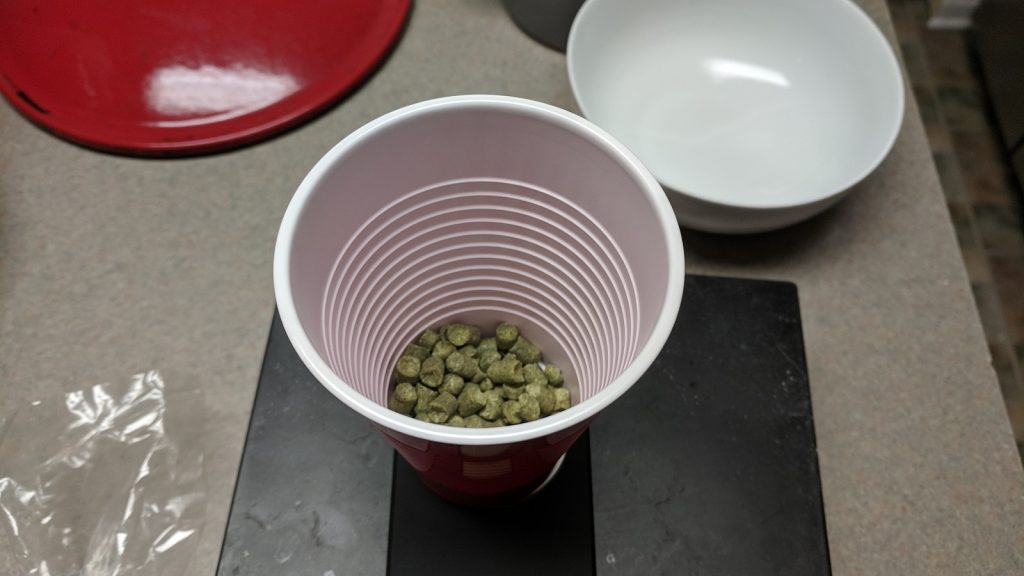
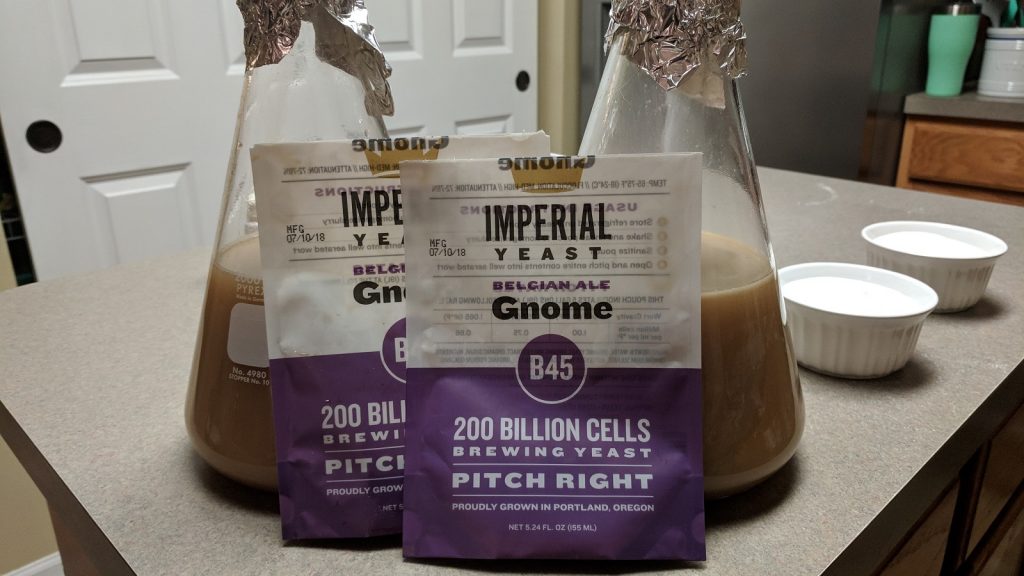
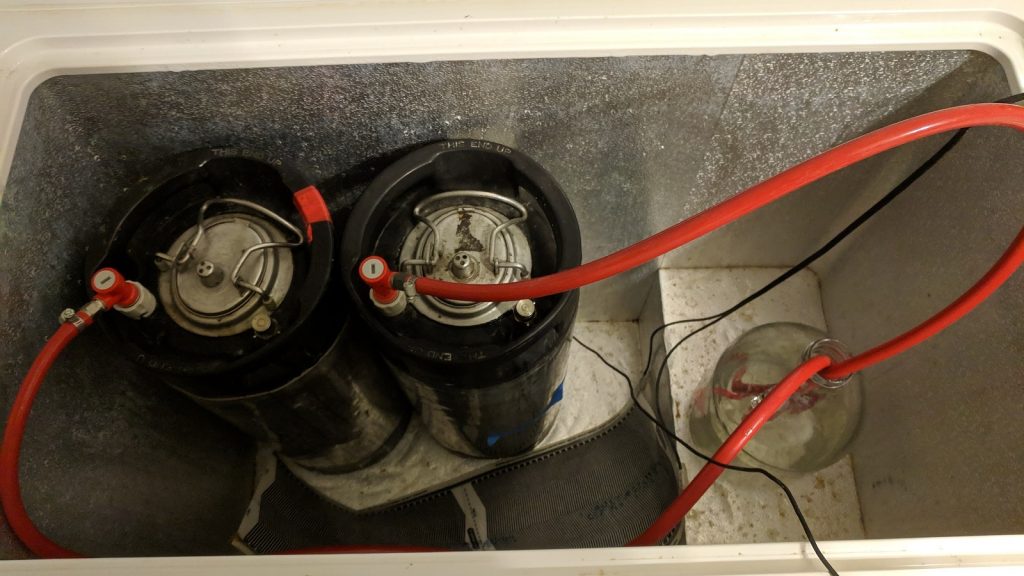











44 thoughts on “exBEERiment | Sugar Additions: Dextrose vs. Sucrose In Belgian Golden Strong Ale”
A follow-up experiment could be to make the same recipe, with one batch pure dextrose and one batch pure fructose. The main reason for this would be to suppress one extra variable. The yeast needs to split the sucrose in dextrose and fructose. It could be that the creation of enzymes for this process is responsible for the taste. A second follow-up experiment should probably be to make from the same amount of sucrose invert sugar and compare that against a pure dextrose batch, and see what this gives.
Love both of those ideas, great suggestions!
I’ve once added some table sugar after the initial fermentation instead of boil with good results for a herbal tripel. Just an idea if you would want to continue experimenting with sugar.
A kilo (or pound) of dextrose has 5% less sugar than a kilo (or pound) of sucrose.
Curious as to why you used the same sugar weights and not the same amount of sugar molecules.
Hey Lup! I legit thought of you when I made this one, we talked a bit about BGSA at NHC last year didn’t we?
So the reasoning for that, as a general rule in the “comparison” xbmts, we try to keep the same weight of ingredients so the variables introduced are a consequence of the ingredient used. So I wanted to use the same percentage of the grist (which is done by weight in BeerSmith) with ingredients homebrewers would use, the corn sugar was from LD carlson.
That said, I’m totally up for re-doing this one or exploring other sugars and examining it by the sugar molecule contribution! The difficulty would come in then identifying if the difference in sugar contributions (2.4 lbs of dextrose v 2.2 lbs of sucrose for example) would cause a difference.
wow. crazy. i cant believe there was a difference.
Me too man, me too. I enjoyed both though, I wouldn’t shy away from either addition if needed.
Interesting to see there’s a difference. Aren’t Belgian ales normally made with sucrose in the form of candi sugar rather than dextrose? I would have thought dextrose (aka glucose) would have a similar effect to rice, which yields starch in the mash that’s broken down entirely to glucose.
It depends on the perspective. Westmalle Tripel is done with candy sugar or invert syrup, but has a higher hop bitterness, while Duvel is done with glucose, and is much lower than Westmalle tripel on hop bitterness. So, it might be that the higher hop bitterness of Westmalle masks this taste, and it could even be that the experiments of professor De Clerck, who helped design the blonde Duvel showed this taste, which lead to using dextrose as adjunct.
Isn’t dextrose unusual in Belgians though? I think most use either candi sugar or candi syrup. I don’t think many commercial belgian breweries use dextrose.
I’m not sure what you mean “this taste”? There’s no evidence of a cidery taste or even off-flavour in the experiment (only one subjective report, while the tasting panel preference was opposite), and I’m still not convinced the cidery effect even exists. I can’t help suspecting that it’s one of those evocative descriptors that spreads via forums but is actually a very rare or maybe even nonexistent problem.
@Ben Morgan (from the article): My Impressions: I had an easy time telling these beers apart, accurately identifying the odd-beer-out in 5 out of 6 semi-blind triangle tests. I perceived the beer made with sucrose to have *an almost harsh character* to it with what seemed to be a somewhat sweeter aroma and flavor, characteristics that were absent in the dextrose version. While I enjoyed both beers, my preference was for the beer made with dextrose.
No taste, but definitely something that can be perceived!
@Jürgen Sure, but that’s just one person’s subjective report and doesn’t amount to scientific evidence. Also note the author says this at the start of the article: “my sugar of choice has always been dextrose”. So you have to factor in an element of bias in the judgement. The tasters preferred the sucrose beer over the dextrose beer (10:8), so presumably didn’t agree that there was a “harsh” off flavour.
I love this. It seems like everything that ” shouldn’t” make a difference does. I’m going to have to start paying attention to what I wear on brew day.
Now THATS an experiment.
Pants vs No Pants, a time-honered brewing debate
I’ve been struggling to identify the source of an apple note in my beers. Perhaps it’s from the sucrose I’ve been bottle priming with?
From my research, cider-like flavor is due the yeast breaking down the sucrose into glucose and fructose during refermentation.
That´s why I don’t understand the result from this exbmt… because if sucrose is insert during boil, it is already separeted into two molecules due acidity and heated environment, and so it shouldn’t have added any diference.. What the hell!
What the hell indeed!
I probably don’t understand the science very well, but Wikipedia says acid inversion is done at a pH of 2.15 and a temp of 122F.
3apple can com from fermentation acetyldehide is the name.
Sub product just like diacetyl.
Longer and higher fermentation temp can help you get rid of it
@Lee, are you brewing all grain or extract, or a hybrid? (I know he posted 2 years ago)
I used to get that “cidery” taste in my beers when I did partial-mash beers, (eons ago) and I attributed it to the tiny bit of sucrose used for bottle priming. I got that idea from Charles Papazian’s books, although I’m not sure it’s actually stated there. I quit brewing for about 20 years and then picked it up again, doing all-grain now. And the cidery taste is gone, even if I add significant (5%) table sugar to the wort in addition to the little bit at priming. I think what was going on before was stale malt extract. I bought a 30# jug of the stuff and stored it in the freezer and used it for several years. It got darker in the freezer, so I know it was oxidizing. I’m not sure what that would contribute, maybe acetaldehyde or something that increases the production of ethyl acetate. Who knows. HTH
It’s interesting to know if the it’s also true for priming beer with sucrose/dextrose
I agree, it would definitely be interesting to look into!
Damnit! I’ve argued for years that corn sugar versus table sugar in bottling makes no difference because “science” and stuff. And table sugar does NOT produce cidery flavors. Now I have to go find all those arguments and take it all back
I curse in your general direction.
There’s no evidence for cidery flavour in this experiment, just a difference between glucose and sucrose. Note the preference was in favour of sucrose, not the other way round. So one conclusion might be that using dextrose instead of the traditional sucrose used in Belgian ales changes the flavour for the worse.
Hey, another great xBeeriment! One question though. In the Recipe Details, you have a 90 minute boil (which is in the XML file), but in the article, you say that you used a 60 minute boil. Which was it?
Thanks for catching that Gary! It was 90 minutes, I’ll update it when I get a second.
When talking about the ingredient, please don’t use “former” and “latter”. It is harder to follow.
For example, “It’s not uncommon for brewers to view dextrose and sucrose as interchangeable, despite the fact the former comes from corn while the latter comes from either sugar cane or beets. ” is easier to follow as:
“It’s not uncommon for brewers to view dextrose and sucrose as interchangeable, despite the fact dextrose comes from corn while sucrose comes from either sugar cane or beets. “
Inconveniences you have to bear for the sake of good writing.
So, we’re here for flowery prose and artistic promise? Shall we sprinkle sucrose over the and around the fermenter as it is more artistic that adding it to the fermenting beer? I just want to blast through the text and not have to re-read something to figure out which is which.
Good to see that an ignorance of the English language is alive and well in the good ol’ US of A… 😉
Tell that to his english teacher 😀
Cidery off flavor is due to fermenting too much simple sugar, it does not matter if it is sucrose or dextrose, so that link between harsh, sucrose, and cidery-like that your are trying to see is really not there, and it is most coincidence. There is really no ground here to support such a claim, especially when these flavour are percieved differently. My oppinion is that it can be simple as that sometimes it is hard to perfectly repeat two condition in two fermentors at home, even side to side.
Another option might be to try invert sugar (common in British styles) vs either sucrose or glucose.
It’d actually be lovely to see a replication of this experiment on its own again, as there’s another possible hypothesis anytime a difference is found – that something went wrong with one of the batches. The description of harshness makes me a bit more suspicious of that than usual.
A nice one would be adding the sugar after three days, an the other one during boiling
I am about to make my first cider kit which requires 2 pounds of dextrose. Considering you noted the “off flavors” of sucrose being described as cidery with a noticeable sweetness I guess I’ll visit my pantry and not my local home brew store for this batch. Thanks for another great xBmt.
Indeed Matt. Having the correct difference in gravity points show how carefully you run the experiment. Congrats!
The difference between dextrose and table sugar is just water and normalizing water content is quite common in science, so I do not see how you can get criticized by using that normalization.
Nonetheless, my comment is really minor and I do not think it was what caused your difference.
I would love a reproduction of your experiment because chemically, there is little difference between fructose and glucose outside of taste.
Hope to see you in New England. Cheers !!
So now what would be the difference if you used Honey or Maple syrup?
Interesting results. My only thoughts are that your recipe called for a significant amount of sugar. Often the only sugar a home brewer uses is to bottle condition. So my question is there a decernable difference between dextrose and sucrose when used just for carbonation. This could be another exbeerment by splitting a single batch of any beer into two parts adding dextrose to one half and sucrose to the other when bottling.
Very interesting exbeeriment!
I am also curious about priming beer with sucrose vs dextrose. Maby, just maby, a DIPA would show even greater difference with 10 % added sugar? That’s because belgian ales usually have candis sugar added, and maby the belgian yeasts more fenolic caracter can hide some of the cider-like caracter?
How would they compare after 12 weeks I wonder?
Great experiment, thanks! I always age my BGSA for much longer. I wonder if the differences in the beers persist over time. I hope you put some aside for comparison down the road
I have only used sucrose but now will try Dextrose for sure. A pretty emphatic decision in this experiment, thanks for a great topic. You have added grams as an alternative for hop additions and it would be great if it was possible to add kg for grain for we metricated countries – I know it is easy enough to convert, but handy to have the quantities right there if it is possible.
Cheers,
Ian
1.007 vs 1.010 seems like a significant difference in the finals beers, did I miss that being addressed somewhere? Both sugars being nearly 100% fermentable, the final gravities should’ve been the same despite the different expected OGs. This would would indicate a difference in the yeast, perhaps lower health in the sucrose batch, that could be the reason for the significant perceived differences between the beers. (different profiles of phenol, ester, fusels, etc.)